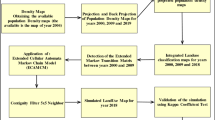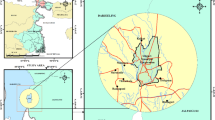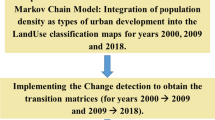Abstract
The identification of properties and land destinations are key factors in urban planning decisions, especially in rapid-growing urbanized cities. This information is vital for cadaster matters, property taxes calculations, and therefore for the financial sustainability of a city. In this work we present a Markov-Monte Carlo simulation model to predict changes in land destinations. First, a Markov chain is established to identify the transition finite-state matrix of property destinations, and then a Monte Carlo simulation model is used to predict the changes. We present a case study for the city of Medellín, Colombia, using historical information from the cadaster office from 2004 to 2016. Results obtained allow identifying the urban areas with the larger number of changes. Moreover, these results provide support for urban planning decisions related to workforce sizing and visits sequences to the identified areas.
Access this chapter
Tax calculation will be finalised at checkout
Purchases are for personal use only
Similar content being viewed by others
References
Berrio Marín, J.A.: Noventa Años De Historia De Catastro Medellín. In: Comité Permanente sobre el Catastro en Iberoamérica (CPCI) (ed.) IX Simposio sobre el Catastro en Iberoamérica, del Comité Permanente del Catastro en Iberoamérica (CPCI) y Celebración 90 años de Catastro Medellín, p. 36. Comité Permanente sobre el Catastro en Iberoamérica (CPCI), IX Simposio sobre el Catastro en Iberoamérica, del Comité Permanente del Catastro en Iberoamérica (CPCI) y Celebración 90 años de Catastro Medellín., Medellin, Colombia (2016). https://www.medellin.gov.co/irj/go/km/docs/pccdesign/medellin/Temas/Catastro/Publicaciones/SharedContent/Documentos/2016/IXSimposioCatastro/4M90AnosCatastroMedellinALBERTOBERRIOMARIN.pdf
Casella, G., George, E.I.: Explaining the Gibbs sampler. Am. Stat. 46(3), 167–174 (1992)
Chib, S., Greenberg, E.: Understanding the metropolis-hastings algorithm. Am. Stat. 49(4), 327–335 (1995)
Concejo de Medellín: Acuerdo 66 de 2017: Estatuto tributario (2017). https://www.medellin.gov.co/irj/go/km/docs/pccdesign/medellin/Temas/Hacienda/Normas/SharedContent/Documentos/2017/Acuerdo066de2017-Medellin.pdf
Congreso de Colombia: Ley 14 de 1983 (1983)
Cowles, M.K., Carlin, B.P.: Markov chain Monte Carlo convergence diagnostics: a comparative review. J. Am. Stat. Assoc. 91(434), 883–904 (1996). http://links.jstor.org/sici?sici=0162-1459%28199606%2991%3A434%3C883%3AMCMCCD%3E2.0.CO%3B2-X
DANE: Series de Población, Reloj Estadistico. Technical report, Departamento Administrativo Nacional de Estadística (DANE) (2016). http://www.dane.gov.co/index.php/estadisticas-por-tema/demografia-y-poblacion/series-de-poblacion
DAP, D.A.d.P.: Acuerdo 48: Plan de ordenamiento territorial de Medellín POT - 2014 (2014). https://www.medellin.gov.co/irj/portal/ciudadanos?NavigationTarget=navurl://474b42d2a001a412ed3117d306a43135
Gelman, A., Rubin, D.B.: Inference from iterative simulation using multiple sequences. Stat. Sci. 7(4), 457–511 (1992)
Geyer, C.J.: Markov chain monte carlo lecture notes. Course notes, Spring Quarter (1998)
Geyer, C.J.: Markov Chain Monte Carlo Lecture Notes (2005)
Gilks, W.R., Richardson, S., Spiegelhalter, D.: Markov Chain Monte Carlo in Practice. CRC Press, Boca Raton (1995)
Grant, J., Tsenkova, S.: New Urbanism and Smart Growth Movements. Elsevier (2012)
Green, D.K.: Efficient Markov chain Monte Carlo for combined subset simulation and nonlinear finite element analysis. Comput. Methods Appl. Mech. Eng. 313, 337–361 (2017)
Hillier, F.S., Lieberman, G.J.: Introduction to Operations Research, 9th edn. McGraw-Hill, New York (2010)
IGAC: Resolución 070 De 2011 (2011)
Kass, R.E., Carlin, B.P., Gelman, A., Neal, R.M.: Markov chain Monte Carlo in practice: a roundtable discussion. Am. Stat. 52(2), 93–100 (1998). http://www.tandfonline.com/doi/abs/10.1080/00031305.1998.10480547
Lee, H.K.H.: Bayesian methods: a social and behavioral sciences approach. Am. Stat. 62(4), 356 (2008). http://www.tandfonline.com/doi/abs/10.1198/000313008X370915
Magnussen, S.: A Markov chain Monte Carlo approach to joint simulation of regional areas burned annually in canadian forest fires. Comput. Electron. Agric. 66(2), 173–180 (2009)
McCabe, T.J.: A complexity measure. IEEE Trans. Softw. Eng. 4, 308–320 (1976)
Muller, M.R., Middleton, J.: A Markov model of land-use change dynamics in the Niagara Region, Ontario, Canada. Landsc. Ecol. 9(2), 151–157 (1994)
Peltonen, J., Venna, J., Kaski, S.: Visualizations for assessing convergence and mixing of Markov chain Monte Carlo simulations. Comput. Stat. Data Anal. 53(12), 4453–4470 (2009)
Raftery, A.E., Lewis, S.: How many iterations in the Gibbs sampler? In: Bayesian Statistics, pp. 763–773 (1992)
Reveshty, M.A.: The assessment and predicting of land use changes to urban area using multi-temporal satellite imagery and gis: a case study on Zanjan, iran (1984–2011). J. Geogr. Inf. Syst. 3(04), 298 (2011)
Schwarz, N., Flacke, J., Sliuzas, R.: Modelling the impacts of urban upgrading on population dynamics. Environ. Model. Softw. 78, 150–162 (2016). http://dx.doi.org/10.1016/j.envsoft.2015.12.009
Sobol, I.: A Primer for the Monte Carlo Method. Taylor & Francis, London (1994). https://books.google.com.co/books?id=P5jWKfR91OkC
Wey, W.M., Hsu, J.: New urbanism and smart growth: toward achieving a smart National Taipei University District. Habitat Int. 42, 164–174 (2014)
Xia, H., Liu, H., Zheng, C.: A Markov-Kalman model of land-use change prediction in XiuHe Basin, China. In: Bian, F., Xie, Y., Cui, X., Zeng, Y. (eds.) GRMSE 2013. CCIS, vol. 399, pp. 75–85. Springer, Heidelberg (2013). https://doi.org/10.1007/978-3-642-41908-9_8
Zhang, J., Tang, W.H., Zhang, L., Huang, H.: Characterising geotechnical model uncertainty by hybrid Markov chain Monte Carlo simulation. Comput. Geotech. 43, 26–36 (2012)
Acknowledgements
The authors acknowledge the support from the Subsecretaría de Catastro of Medellín, for providing the necessary information for this study.
Author information
Authors and Affiliations
Corresponding author
Editor information
Editors and Affiliations
Rights and permissions
Copyright information
© 2018 Springer Nature Switzerland AG
About this paper
Cite this paper
Castillo, J.A., Ceballos, Y.F., Gutiérrez, E.V. (2018). A Markov-Monte Carlo Simulation Model to Support Urban Planning Decisions: A Case Study for Medellín, Colombia. In: Figueroa-García, J., López-Santana, E., Rodriguez-Molano, J. (eds) Applied Computer Sciences in Engineering. WEA 2018. Communications in Computer and Information Science, vol 915. Springer, Cham. https://doi.org/10.1007/978-3-030-00350-0_29
Download citation
DOI: https://doi.org/10.1007/978-3-030-00350-0_29
Published:
Publisher Name: Springer, Cham
Print ISBN: 978-3-030-00349-4
Online ISBN: 978-3-030-00350-0
eBook Packages: Computer ScienceComputer Science (R0)




